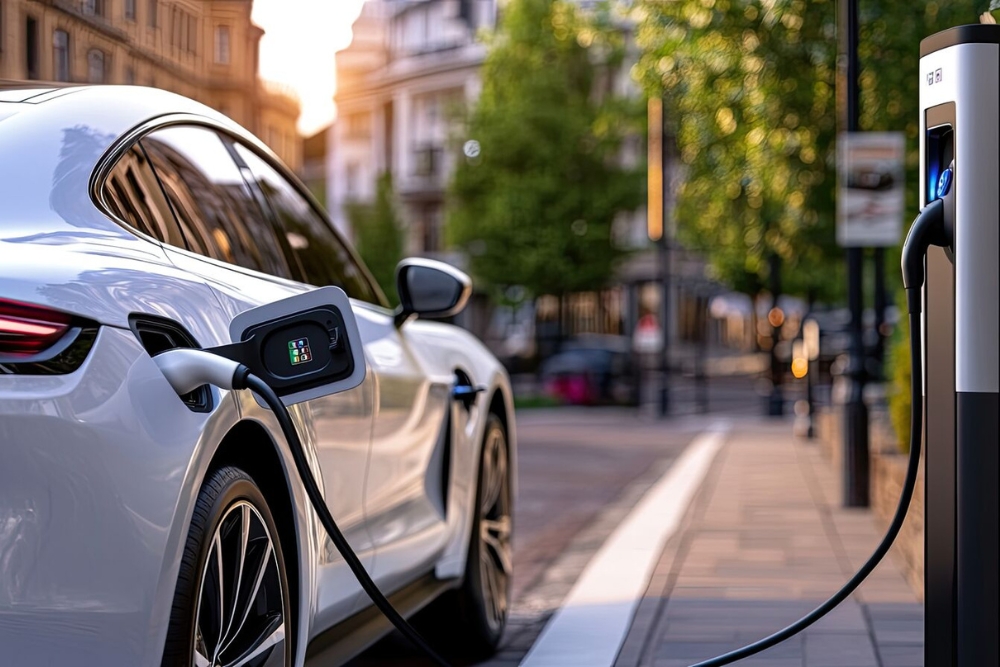Are EVs the answer to urban mobility?
By SG Fleet | 26 May 2025

Urban traffic and pollution are major concerns for UK cities. London’s Ultra Low Emission Zone (ULEZ) charges £12.50, and the Congestion Charge is £15 per day for polluting vehicles, so fleet managers with drivers who enter the zone are sure to feel the squeeze. Fully electric vehicles (EVs), however, meet the required emissions standards for both the Congestion Charge and ULEZ, so your company could drive without paying the fees if you switch to electric.
Driving down emissions and costs
UK cities have set ambitious targets for cleaner air and carbon reduction. The Mayor of London aims for net-zero by 2030 and for new petrol/diesel cars to be phased out by the same deadline. Transport makes up about 27% of the UK’s greenhouse gases, so fleets are facing increasing pressure to decarbonise here too.
Company fleets are leading the way here.
In 2023, around 22% of new fleet cars registered in the UK were electric, and fleet purchases now make up roughly three-quarters of all new EV sales nationwide. Business tax breaks played a part in driving the uptake.
EV company cars currently pay 3% Benefit-in-Kind tax (set to rise 1% each year until 2028) instead of around 30% on petrol cars. Combined with the existing ULEZ and Congestion Charge exemptions, electrification quickly becomes a budget-friendly choice for fleets. EVs produce no tailpipe nitrogen oxides, improving air quality, which has seen London’s ULEZ cut nitrogen oxides by 26% in its first four years. That’s the equivalent of pulling 200,000 old diesel vehicles off the roads, and broader uptake in electrification from fleets would amplify that effect.
The numbers behind electrification
A quick look at the figures tells the story. EVs typically cost about £1,150 per year to run for 10,000 miles, versus about £2,320 for a comparable petrol car, over 50% less. Most of that saving is made from energy, as the electricity to run an EV for that distance costs less than 1/6 of the equivalent of petrol.
Maintenance is cheaper, too.
The same study found that the average EV servicing cost was about £230 annually, as opposed to £295 for a petrol car. This means that, by electrifying your fleet, you can cut maintenance costs drastically.

The combined savings shouldn’t be overlooked.
If you’re an urban business looking at car leasing or fleet options, the combined savings of switching to an electric fleet are huge. The fee savings alone (£27.50/day) mean that you could save up to £4,000 per year per vehicle, and that’s before factoring in tax, servicing, and fuel savings.
Beyond the bottom line
If we want our UK cities to breathe easier and keep us healthier, then EVs are clearly the best course for mobility. From a carbon standpoint, EVs usually rack up higher production emissions, but they pay off that ‘carbon debt’ in less than two years on British roads, thanks to a grid that’s steadily getting greener. They also go on to emit roughly two-thirds fewer lifetime emissions than petrol cars.
Could EVs be the answer to heat islands?
Modelling suggests a full fleet switch could shave almost 1 °C off local air temperatures, easing summertime stress on pavements and air-con units. And that’s not just theoretical – London’s infamous heat island already amplifies heatwaves, so any improvement is likely to benefit residents, workers, and tourists across the capital.
Improved air quality
Urban public health could get a lift from companies switching to electric fleets, too. Recent research links every new EV on the road to one fewer asthma case. Granted, tyres still shed particulate matter, and battery disposal needs careful handling, but compared to the current dependence on petrol and diesel vehicles, EVs can bring us greener cities and cheaper mobility.
Infrastructure and support
Range anxiety is also reducing as the charging network expands. The UK now has nearly 80,000 public charging points (and over 1 million off-street sockets at homes or workplaces). Even more crucially, more than 90% of charging happens at home or at a depot, which plays to fleet strengths.
Businesses can install chargers at their premises (something that’s included in our eStart solution), and grants cover up to 75% of these costs, with a total value of up to £15,000 per site. Local councils are also rolling out on-street chargers, and this isn’t limited to urban areas.

Looking to transition to an EV fleet?
SG Fleet’s double-award-winning eStart solution is built to guide businesses through every step of electrifying their fleets. Our experts help assess your vehicles and charging needs, plan charge point installations, and create a roadmap that’s aligned with your business objectives.
With eStart, companies can de-risk the switch, as detailed planning and site assessments mean no hidden costs or surprises later. We’re always honest about how industry fluctuations like the Road Fund License changes impact your move to EVs. We factor in each aspect to give you a fully transparent view of the real costs and savings before you make the move. It’s the perfect way to kickstart an electric fleet.
Ready to make the switch? Visit our eStart page to learn more, or get in touch today to book a full consultation with our team.
FAQs
Are EVs exempt from London’s Congestion Charge and ULEZ?
EVs are entitled to a 100% discount, which essentially amounts to full exemption. They also do not meet the emissions threshold required for a daily ULEZ fee.
How do EV running costs compare?
EVs are much cheaper to run, with one analysis finding that 10,000 miles use only £174 of electricity versus £1,209 of petrol.
How easily can fleets charge EVs?
Very easily; at SG Fleet, our eStart solution includes charging infrastructure so your business can hit the ground running when it comes to electrification.


.png)


.png)
.png)
.png)